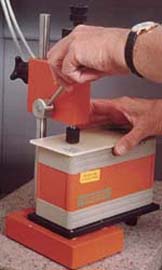Surface Hardness Testing Improves Material Quality and Performance
A device from Fischer Technology helps an automotive supplier provide better quality injection molded plastic parts.
A new approach to measuring the hardness of injection molded plastic components is helping researchers at Visteon Automotive Systems (Dearborn, MI) control the molding process to achieve improved material properties.
Launched in September 1997 to provide fully integrated systems to Ford Motor Co., other original equipment manufacturers, Tier One customers, and aftermarket products manufacturers, Visteon is organized by systems groups that include chassis, climate control, electronics, glass, interior/exterior, and powertrain control systems. The company offers its customers a wide array of product lines comprising 27 automotive systems, 10 modules, and 66 component categories.
In its short history, the company has established a reputation for developing advanced technologies – such as Super Integration (SI) technology – that deliver systems with improved quality, reliability, and major reductions in weight and cost. Each of the company's systems groups focuses on improving materials and components to provide auto makers with viable design and assembly alternatives.
The exterior systems group develops new types of plastics, most based on thermoplastic olefins, that have improved paintability characteristics and resistance to surface damage, and are lighter in weight than conventional automotive plastics.
"One of the characteristics that strongly influences surface damage resistance and paintability is the surface hardness, the surface crystalinity," said Dr. Rose Ryntz, a Visteon technical specialist in materials development. "The injection molding process itself can affect surface hardness; factors such as the time it takes to fill the tool, the temperature of the melt, pack pressure, the difference in temperature between the mold and the melt, and the injection speed all act together to create unique properties in the materials."
Understanding the Process Through Measurement
To determine precisely how molding process factors influence surface hardness characteristics, it was necessary to accurately measure surface hardness of different formulations of thermoplastic olefins. Dr. Ryntz and other materials development specialists used standard industry hardness test methods, but felt that the values from these tests weren't precise enough to be used for gathering correlation data needed for a true assessment of molding variables.
Dr. Ryntz decided to try a different approach to measuring surface hardness using the Fischerscope H100 testing instrument from Fischer Technology (Windsor, CT). The device measures ultra-low load hardness under test load, and with a load range of 0.4–1,000 mN, provides maximum sensitivity over a wide range of materials and coatings.
The H100 consists of a programmable X-Y stage with a travel of 2 x 2 in. and a positioning accuracy of 1 µm, a metallurgical microscope with a maximum magnification of 1,000 X, a control unit, and a hardness test head. It provides such material property data as hardness, elasticity, plasticity, and modulus of elasticity. The system can be used on materials with very thin coatings as well as uncoated materials.
"We're concerned with the top 100 micrometers or less of the plastic. We tried the Fischerscope H100 and found it to be one of the only ways to get the kind of data that we wanted," Dr. Ryntz noted.
Research has shown that after the first 20% of penetration into the film thickness, the substrate has an increasing effect on measurement. With the Fischerscope H100, operators can precisely control the load and indentor penetration so the effects of the material substrate on measurement results can be virtually eliminated.


Precision Testing Gathers Accurate Data
The test method gradually increases the load step-wise on an indentor placed onto the material. The number of incremental test load steps can be set from 1–300 and time-dependent test load applications are selectable. The increasing load and depth of penetration into the material are graphed. To evaluate material creep, a predetermined maximum load is applied, the load is maintained for a fixed time, allowing additional material penetration. This depth is graphed. The load is removed gradually and the changes in load against indentation are graphed. Test results are stored in the computer and displayed. The very light loads provide what is practically a non-destructive test, permitting the sample material to be used for subsequent tests.
Visteon runs two types of hardness tests – one to determine the material's resistance to damage and another to determine its paintability.
In a typical surface hardness evaluation, a molded plastic plaque about 4 x 12 in. is placed on the H100's stage. A load between 100 mN and 1,000 mN is placed on the plaque in 60 steps. The corresponding data that Visteon uses is the H-plast and WR/WT values from the unloading. Similar tests are conducted on painted plastic plaques to determine the influence of curing time on the materials ability to accept paint and resist scratches.
There is a direct relationship between surface hardness and paintability and damageability. The harder the surface of the thermoplastic olefin, the more it resists scratches and shear loading. But the harder the surface, the more difficult it is to paint, so a compromise is necessary.
Without the ability to precisely measure surface hardness, elasticity, and plasticity, it would be difficult to understand and control the injection molding process well enough to result in improved material properties.
"From the data we collect, we can correlate back to the molding conditions and determine what conditions will result in optimal surface hardness for improved paintability and darnageability of the material," Dr. Ryntz said. "There are other factors involved too, but knowing the hardness and elasticity, or plasticity, helps us determine how the material will perform as an exterior trim component."
For more information, contact Fischer Technology, Inc., 750 Marshall Phelps Rd., Windsor, CT 06095. Tel: 800-243-8417; Fax: 860-688-8496.
